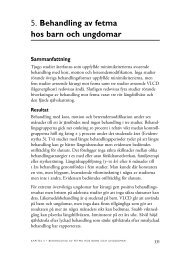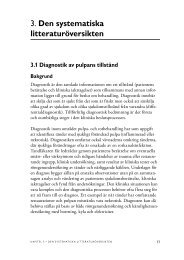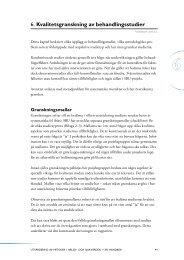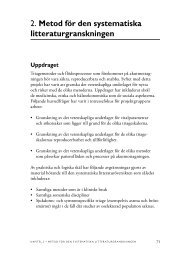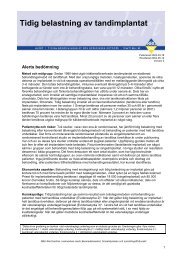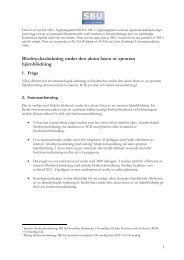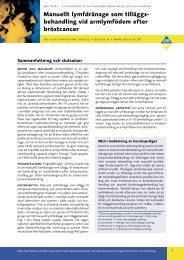Download our latest issue - SBU
Download our latest issue - SBU
Download our latest issue - SBU
You also want an ePaper? Increase the reach of your titles
YUMPU automatically turns print PDFs into web optimized ePapers that Google loves.
English Special 2013<strong>SBU</strong> – Swedish Council on Health Technology AssessmentMEDICALSCIENCE& PRACTICENEW REPORTS <strong>SBU</strong> Results in Brief | 11–15How CanQuality of LifeBe Measured?How do different treatment methodsaffect patients’ quality of life? Thisquestion is key in health care. But findingappropriate methods to measuresatisfaction with life is a challenge thathas eluded scientists for decades.Daniel DayHealth is important for <strong>our</strong> quality of life.Many people would say that their qualityof life is equally important as the symptomlevel or other signs of disease.For instance, people who contract alife-threatening disease do not concernthemselves only with how many monthsor years that treatment can extend life.They also want to know what their situationis likely to be during that time – forinstance, whether patients are usuallyable to live life as before.The question of how different treatmentsaffect quality of life is importantto patients, carers, and decision makers.Quality of Life | 1 Worthwhile Effect | 4 Evidence & Decisions | 6 Harmful Psychology | 8Recent <strong>SBU</strong> Findings | 11–15
A Pseudo-Informed PhysicianWith increasing discomfort, I look across the dinnertable at B, a know-it-all physician in his prime. Hechews energetically on a pasta salad and is obviouslyproud of his minute – and wordy – analysis of the problemswith today’s health care.–You know, evidence and such drivel is the devil’s owninvention, he finally explains with a smug smile.– What?– Yes, a malignant conspiracy amongst a lot of idlebureaucrats and some unsuccessful researchers whocouldn’t survive the competition. What do they knowabout care and patients? With their blasted me-e-e-taanalysesthey wouldn’t last twenty minutes in my clinic!– Are these s<strong>our</strong> grapes, or what are you talkingabout?– They think they’re experts on how to provide thisglo-o-o-rious evidence based care, but they’ve never beenclose to the actual delivery of care, says B, and then takessuch a large swig of beer that I’m able to interject.– Hey come on, I say. Are you telling me it’s unnecessaryto review the best available research on treatments?What’s the alternative? Where are you going to find y<strong>our</strong>scientific support and benchmarks, might I ask? In some“good old boy” network? Or in 30-year-old textbooks? Orin y<strong>our</strong> own magic formulas?– Well, it’s not my job to mess around with suchdetails. It’s y<strong>our</strong> job.Now I’m getting irritated.– But please, B, do tell me how you are keeping upwith what the research shows, so you are able to deliverthat amazingly effective care that you claim to provide.– Google, responds B contentedly. I don’t claim toknow everything, so when I need to refresh my memory Iuse Google. Takes five seconds to pull up the evidence.– OK. And you trust what you find in those five seconds?Amongst one hundred and eighty thousand hits?– Yup. Of c<strong>our</strong>se you can see whether it’s publishedby a professor or some research institute.– Beg to differ. A few scientific articles that you or Ior someone else stumbles over on the Internet do notmake up evidence. Evidence is made up of systematicallycollected, quality-reviewed and evaluated findings from allavailable research.– Yah, yah, so it is Ragnar. Like I usually say: Evidenceis as important to health care as ornithology is to birds,ha ha. By the way, did you have some problem with y<strong>our</strong>shoulder that I should look at before I have to go?– Nah, thanks anyway. Suddenly it feels much better.On the way home with my aching shoulder I contemplatethe assignment that the Government gave <strong>SBU</strong>last summer – to investigate ways to establish a national,Web-based library for health services. A site to helphealthcare staff find evidence and other useful informationall in one place – a res<strong>our</strong>ce requested by many. But noteveryone. A physician like B might never recognize howmuch he needs it.RAGNAR LEvI, EDITORJosé Luis PalaezBut measuring quality of life iseasier said than done – eventhough the methodology hasadvanced in recent decades.JUNGLE of mE t hodsA jungle of measurementmethods is now available toaddress health-related qualityof life. When researchersin Oxford inventoried thesemethods they found 1275 differentformulas.One explanation for thismultitude of instruments isthat they may have been developedfor different purposes.Clinical researchers wantto compare the effects of differenttreatments on patients’function and well-being,while public health experts focuson general changes affectingthe quality of life of differentgroups in society. Andhealth economists involvedin pricing drugs and prioritisinghealthcare interventionswant to compare the costs ofdifferent ways to achieve aparticular improvement in thequality of life.Some questionnaires aregeneral, generic, and can beused regardless of the type ofhealth problem. Others areadapted to different diseasesand conditions. The diseaseorcondition-specific formulasare more sensitive than thegeneral ones – they provide amore detailed description andcan capture several importantfunctions. On the other hand,they can miss side effects andother essential factors concerningother organ systems.The different measurementmethods also yield differentresults.Another difficulty in researchis that <strong>our</strong> expectationshave a strong influence on thequality of life. Jan Liliemark isprogramme director at <strong>SBU</strong>,oncologist, and professor ofpharmacotherapy.– In addition to all othermeasurement problems it’simportant whether the qualityof life is measured directlyafter onset, or after a period oftime, in the c<strong>our</strong>se of disease,he says.PERCEPt I o N s C h A NGE– Many patients can adjust toa serious disease or functionalimpairment, e.g. cancer. Theyadapt to their new situation.<strong>SBU</strong> SCIENCE & PRACTICE – HTAI 2013
Even though the quality oflife decreases radically at first,perceptions often changelater. Researchers need toconsider this.Studies that compare theeffects of different treatmentson quality of life should alsomask who receives whichtreatment; otherwise expectationsinfluence the outcome.Since dropout is oftensubstantial, another questionconcerns how to manage thisin studies involving quality oflife, says Jan Liliemark.N o fo LLow-U P s– Many of the test subjectsare never followed up. Themost severely ill are unableto participate through theentire study, which skews theresearch findings.But perhaps the greatestchallenge involves determiningthe value of the measuredchanges in quality of life. Howimportant are they, actually?Does the starting point fromwhich the quality of life becomesbetter or worse play arole? How much do we thinka particular change in qualityof life is worth at differentlevels of health?In attempting to factorin the public’s perspective,health economists use anindex, a tariff. This has beencalculated using a sample of(mostly healthy) people in thepopulation who have set hypotheticalvalues on differentstates of health. The researchersasked them to imaginethat they had been afflictedby different conditions andfunctional impairments andappraise how high or lowtheir quality of life would be.Here, methodological problemsarise.– Of c<strong>our</strong>se it’s difficult toset a value on a state of healththat one has never experienced,says <strong>SBU</strong>’s EmelieHeintz, whose PhD thesispursues the topic from a perspectiveof health economics.BRIt I sh f I GUREsThe values, however, differin different countries. Forthe EQ-5D instrument alonethere are 18 different tariffs.Nevertheless, an indexbased on the values of theSwedish population does notexist. Sweden uses figuresbased on samples from theBritish or Canadian populations.Despite the shortcomingsof the tariffs, Emelie Heintzthinks it is good to at least tryto consider the public’s valuesregarding quality of life.Decision makers need tobe aware of the functions onwhich people in general placethe highest value, she says.However, she would like tosee greater awareness abouthow to calculate the qualityof life.– For example, you can arriveat totally different resultsdepending on the generalformula you choose. Oneformula might show that atreatment improves the qualityof life for patients, whileanother formula shows noeffects at all.– And this is not a purelyacademic question. The tariffsand the estimated costs toachieve a certain level of improvementare used in specificdecisions about which drugsshould be financed with publicfunds and included amongthe pharmaceutical benefits.Quality of life is changeableand difficult to measure.It is reasonable to place highstandards on the measurementmethods, which mustbe scientifically appraised fortheir area of utilisation.To forgo measuring qualityof life is a poor alternative.Then we would mostdefinitely remain in the darkabout how patients actuallyfeel. [RL]Further ReadingGarratt A, et al. Quality of life measurement:bibliographic study of patientassessed health outcome measures.Brit Med J 2002;324:1417.Layard R. Happiness: Lessons from anew science. London: Penguin. ISBN9780141016900.Carr AJ, et al. Is quality of life determinedby expectations or experience?Brit Med J 2001;322:1240.Chassany O, et al, for the ERIQAgroup. Patientreported outcomesand regulatory <strong>issue</strong>s: the exampleof healthrelated quality of life. DIAJ<strong>our</strong>nal 2002;36:20938.whAt Is QUALIt Y of LIf E?Quality of life is a broad measure comprisedof an individual’s appraisal of theirphysical, mental, and social wellbeing.According to WHO, quality of life addressesan individual’s perception of their lifesituation in relation to the current cultureand norms, and in relation to their owngoals, expectations, values, and interests.By definition, it is a personal experienceinfluenced by changes in one’s life situationand which varies with time.Even though health has a major influenceon quality of life, other factors in the environmentnaturally play a role, e.g. familyand friends, work and free time, economics,housing, education, and associatingwith other people.The concept of healthrelated quality oflife encompasses the aspects of generalquality of life that are influenced by health.This is of interest in clinical research whenstudying the effects of different care interventionson patients’ quality of life, andnot only on symptoms and survival. Healthrelatedquality of life is also meas ured inpopulation studies for planning and followupof public health initiatives.Various qualityoflife measures are usedfor health economic comparisons of differenttreatments – for instance, comparingthe cost of gaining a qualityadjusted lifeyear through different interventions.The instrument used can be categorised asgeneral and disease- or condition-specific.The general instruments should make itpossible to compare patient groups, whilethe specific ones aim at a more detailedprofile of a particular type of health problem.Specific instruments have becomeincreasingly common.A general method used in many clinicalstudies is SF-36. Disease or conditionspecificinstruments include the EORTC QLQbattery of questions for various cancers,Asthma Quality of Life Questionnaire, andSt. George’s Respiratory Questionnaire.The health economic calculations arebased instead on information from generalmethods such as EQ-5D, SF-6D, andHUI-3.<strong>SBU</strong> SCIENCE & PRACTICE – HTAI 2013• 3
When are Small EffectsBig Enough?Further ReadingFerreira ML, et al. A critical review ofmethods used to determine the smallestworthwhile effect of interventionsfor low back pain. J Clin Epidemiol2012;65:25361.Ferreira ML, et al. When is a furtherclinical trial justified? Brit Med J2012;345:e5913Chalmers I, et al. Avoidable waste inthe production and reporting of researchevidence. Lancet 2009;374:869.Levi R. Ställer forskarna rätt frågor?[in Swedish] Vetenskap & praxis nr34/2010: 13.Although the difference betweentwo treatments maybe statistically significant,i.e. confirmed by an acceptablestatistical margin, itis not necessarily clinicallysignificant. The socalledp-value in statistics has nointrinsic value.Showing statistically sig ni -ficant differences betweendifferent interventions oftensatisfies researchers. If sufficientevidence shows that onetreatment has superior effectsover another, then they claimthat <strong>issue</strong> is settled.But the critics argue thatthis standard – the need toshow a statistically significantdifference between the methods– is far from sufficient. Itdoes not differentiate betweentrivial effects and valuableeffects.Before we draw the conclusionthat one interventionworks better than another,we should decide how great adifference is necessary to playany role for the patient – atype of threshold value. Weought to ask: How small is theminimum difference in termsof clinical importance?CoINEd CoN CEPtMore than 20 years agosomeone coined the conceptof minimal clinically importantdifference, also calledthe smallest worthwhile effect.This refers to the smallestimprovement that patientsperceive as beneficial and thatwould motivate a change intreatment strategy – assumingthat the side effects and costsfor the more effective methodare acceptable.But changing the focusfrom statistical significanceto clinical relevance hasbeen slow, according to RobHerbert, Associate Professorof Physiotherapy at theNeuroscience ResearchInstitute in Sydney, Australia.soLE foCUs– Although the problem hasbeen discussed for decades,we often continue to focussolely on p-values and confidenceintervals when weinterpret research findings,he says.– For instance, many readersof the Cochrane reviewslook only at whether the diagramshows if one or anothertreatment option is better.And in fact this is just asuninteresting as reporting thep-value of an individual study.They should also be looking atthe differences in size, both inabsolute and relative terms.– Although tempting, it ispremature to draw conclu-P-VALUE ANd s IGNIf ICANCEWhen researchers statistically analyse clinicalresearch results they usually conduct astatistical hypothesis test. This is a test thatinvestigates whether the results measuredin a randomised study (e.g. a differencebetween two groups – treatment groupand control group) are statistically significant.The hypothesis tested in the study iscalled the null hypothesis.The null hypothesis means that the treatmentshows no difference compared tocontrols (e.g. that treatment is no better4 •than placebo). If the null hypothesis isvalid, the study is unlikely to show a difference.The pvalue indicates the probabilitythat such a difference would have arisenby chance – even though the null hypothesisis true. A pvalue of 0.05 indicates thatthis probability is only 5%.When the pvalue is so low, we usuallychoose to reject the null hypothesis. Wesay there is a difference that is statisticallyconfirmed at the 5% level, or statisticallysignificant.But a statistically significant differencebetween the groups does not necessarilymean that it is clinically relevant. In a studythat includes a sufficient number of participants,even a minimal difference in effectthat lacks clinical importance can achievestatistical significance.In contrast, if a study is too small and hastoo few participants, the opposite problemarises. Not even an effect difference thatis actually important would then achievestatistical significance.
sions about “winners” and“losers” among treatmentmethods based only onstatistically significant differences.Concurrently, we mustalways ask: How much betteror worse is the respectivemethod? Does this matter?Preferably, every study thatcompares different treatmentmethods should be designedand interpreted from thestandpoint of such knowledge,says Rob Herbert.– It’s not really meaningfulto commit res<strong>our</strong>ces to differencesthat patients view ashaving no value.Together with colleagueManuela Ferreira and otherco-workers, Rob Herbert hasstudied how researchers haveaddressed the <strong>issue</strong> in theirown area, i.e. treating lowback pain.EXPERt s’ PERCEPt I o N s– Most experts have reliedon their own – and not thepatients – perceptions aboutappropriate clinical thresholdvalues and reasonablesacrifices to achieve them. Forexample, many equate “smallestmeasurable effect” with“smallest important effect”.They assume that the smallestidentifiable effect is always ofinterest, says Rob Herbert.– Instead, it should be thepatients themselves who determinewhat is a reasonablebalance between a chancefor improvement, on the one<strong>SBU</strong> SCIENCE & PRACTICE – HTAI 2013hand, and the risk for side effectsand costs, on the other.The patients’ values shouldguide the choice of treatmentmethod.The constant quest ofresearchers for low p-valuesalso has consequences fortheir future research, notesRob Herbert. Since expertsand patients may disagreeabout the value of a giventreatment effect, they mightalso have different opinionsabout the value of conductingfurther studies to improvestatistical significance.mEANINGLEss QU E s t I o N– The immediate reactionof many researchers is toconclude that if we do onlyone more treatment studyof sufficient size, we will beable to improve the situationfor patients. However, there’sno guarantee that the resultsof a new study, regardlessof its size, would benefit thepatients.– In the worst case, itwould only provide a moredefinite answer to a meaninglessquestion.Clinical research often aimsto eliminate uncertainty aboutthe effects of a treatment. Butthe interesting question isactually whether or not thenew study reduces patients’uncertainty about the value ofthat treatment. [RL]Jorg Greuel¨/Getty• 5
Evidence Alone Will NotSuffice for Care DecisionsEvidence has becomeeveryone’s catchword –scientists, j<strong>our</strong>nalists, andpoliticians. But evidencedoes not lead in a straightline to decisions, notesJesper Jerkert, Teacher inPhilosophy.Many want to cite evidencewhen they make decisions.The researchers that promotedthe concept of evidencebased medicine (EBM) explainedfrom the outset thatan important goal is to makebetter healthcare decisions,to offer each patient the besttreatment. Thus, EBM is notonly about compiling existingevidence, but also about usingthis knowledge in medicalpractice. 1 But when it comesto the practical application ofevidence, misunderstandingsoften arise among both theadvocates and critics of EBM.People draw a straight linefrom evidence to decisions.But it can never be quite thatsimple.ACCEPt E d to o LThe most widely accepted toolfor evaluating medical technologiesin terms of clinicalstudies, i.e. GRADE, includesan evidence component and arecommendation component. 2The evidence componentdescribes the actual scientificevidence, and the recommendationcomponentrecommends the treatmentsthat should be prescribed inconcrete cases. The CochraneCollaboration, which compilesreports on the medicalevidence available in differentareas, uses GRADE – but like<strong>SBU</strong>, only the evidence component.Hence, these reviewsnormally do not present anytreatment recommendations.Even if a Cochrane reviewshows for instance that treatmentA has a greater effectthan treatment B, this is usuallyinsufficient for makingdecisions about which methodwould be most appropriatefor an individual patient,or which one should receivepriority in health services generally.Go BE Yo N dThe Cochrane Collaboration’sinstructions for systematicreviews assert that treatmentrecommendations requireconsiderations that go beyondthe actual systematic review. 3What are the considerationsthat lead from evidenceto decisions? Two questionsare important links in thechain: Is the cited evidencerelevant to the decision?Which (possibly implied) valuesare fulfilled if the correctdecision is made?Exactly what may be consideredrelevant in this contextcan be discussed. JeremyHowick, who is closely associatedwith GRADE, has listedf<strong>our</strong> criteria for relevance 4 :• The effects must addresssomething important tothe patient and not simply asurrogate measure. In otherwords, one must show a positiveeffect on well-being and/or longevity, not simply, e.g.blood values.• The positive effects mustoutweigh the possible negativeside effects.• Evidence on treatmenteffects must address typicalpatients. In other words, thestudy must apply to realworldconditions, not onlyanimal experiments or selectedgroups of people that differsubstantially from those whotypically present themselvesfor treatment.• The treatment must becompared with other optionsfor the condition in question.People cannot make decisionsif there are no alternatives tochoose from.GoA L Not A s CLEARAs regards values, an interestingfundamental differenceexists between evidencebased medicine and otheractivities said to be evidencebased, e.g. evidence basedcorrectional care or evidencebased education. 5 In medicine,what we want to achievewith the interventions underreview is relatively uncontroversial;everyone agrees thatgood health is the goal (eventhough the scope of the conceptmay differ). In correc-6 • <strong>SBU</strong> SCIENCE & PRACTICE – HTAI 2013
tional care and education thegoal is not as clear – there ispolitical disagreement aboutthe most appropriate aims ofthese services.m AY dI sAGREEEven if everyone agrees aboutthe general goals of healthservices, people may still disagreeon several other valuesincluded in the health decision.This becomes particularlyapparent when discussingeconomic aspects.Assume for instance thatthere are effective interventionsfor several diseases,but they are found to be tooexpensive for preventing ortreating all of these diseasesin the population. A list ofpriorities will be needed toappraise which problems areof greater or lesser importancefor health services to treat orprevent.CoN f LICt I NG VA LUEsConflicting values do not necessarilyconcern economics,nor do they necessarily meanthat different diseases areweighed against each other.Different patients, even thosewith the same disease, mayhave different opinions aboutwhat they hope to gain fromhealth care.It is also conceivablethat the expected statisticaldistribution of a treatmenteffect ought to determinehow strongly the method is<strong>SBU</strong> SCIENCE & PRACTICE – HTAI 2013Dietrich Madsenrecommended. The averagetreatment effect (i.e. the effectat the group level) is notnecessarily the only outcomeof interest. Assume that theeffect of a treatment is positiveon average, but it varieswidely among different individualswith the same disease.While some patients improveconsiderably, others may notimprove at all, or might evenget worse. If this variation isreal (i.e. does not simply reflectstatistical uncertainty inthe studies) it is not self-evidentthat the treatment can berecommended generally.Moreover, patients andhealth services may view thissituation in different ways.The individual patient’s viewof the possibility for improvementversus the risk of deteriorationcan differ from thatof the healthcare provider.Necessary elements involvingvalues in care decisionsare often forgotten – eventhough it has long been assertedthat evidence-basedclinical decisions must combineevidence (systematicallycollected and quality-gradedresearch findings) with clinicalexperience and patients’ valuesin each care situation. 6PREs E NCE of VALUEsSome argue that the mix ofvalues and knowledge thatcare decisions inevitably involveshould not be calledevidence based. Instead, weshould find terminology thatmore clearly indicates thepresence of values. 7,8 Personally,I do not think this isrealistic. We probably have toaccept that evidence basedactivities are not based entirelyon knowledge. Decisionmaking also encompassesquestions about relevance andvalues.Jesper Jerkert, DoctoralStudent, Adjunct in ScientificPhilosophy, KTH, StockholmMember of <strong>SBU</strong>’s lay panelReferences1. EvidenceBased Medicine WorkingGroup. EvidenceBased Medicine:A New Approach to Teachingthe Practice of Medicine. JAMA1992;268:24205.2. Grade Working Group, Introduction,http://www.gradeworkinggrouporg/intro.htm.3. Cochrane Handbook for SystematicReviews of Interventions, version5.1.0, Mar. 2011, section 12.7.2 (Implicationsfor practice).4. Howick, J. The Philosophy ofEvidenceBased Medicine. Chichester:WileyBlackwell/BMJ Books, 2011.5. Davies, P. (1999). What is EvidencebasedEducation? British J<strong>our</strong>nal ofEducational Studies 47(2), 108121.6. Sackett DL, et al. Evidence basedmedicine: what it is and what it isn’t.Brit Med J 1996;312:712.7. Saarni SI, et al. Evidence basedmedicine guidelines: a solution to rationingor politics disguised as science,J<strong>our</strong>nal of Medical Ethics 2004;30,1715.8. Davies P. What is EvidenceBasedEducation? Brit J of Educ Studies1999;47:108121.• 7
Studying the Shadowsof PsychologyReferences1. Pitrou I, et al. Reporting of safetyresults in published reports of randomizedcontrolled trials. Arch InternMed 2009;169:175661.2. Ioannidis JP, et al. Improving safetyreporting from randomised trials. DrugSaf 2002;25:7784.3. Papanikolaou PN, et al. Safety reportingin randomized trials of mentalhealth interventions. Am J Psychiatry2004;161:169297.4. Lilienfeld SO. Psychological treatmentsthat cause harm. Perspectiveson Psychological Science 2007;2:5370.5. Barlow DH. Negative effects frompsychological treatments: a perspective.Am Psychol 2010;65:1320.6. Devilly GJ, et al. The investigationof exposure and cognitive therapy:comment on Tarrier et al (1999). J ConsultClin Psychol 2001;69:11416.7. White PD, et al. Comparison ofadaptive pacing therapy, cognitivebehavi<strong>our</strong> therapy, graded exercisetherapy, and specialist medicalcare for chronic fatigue syndrome(PACE): a randomised trial. Lancet2011;377:82336.Psychological treatment isoften perceived as harmless.But despite examplesof unexpected negativeeffects, research onpsychological methodsseldom mentions adverseeffects. An American articlepresents reason for concern,writes psychologist UlfJonsson, Research Associateat <strong>SBU</strong>.Psychological interventionsare often an integral part ofthe services offered throughboth psychiatric and somaticcare. Moreover, psychologicalmethods are used to promotehealth and prevent ill healthin risk groups.Many well-executed studieshave shown the effects ofsuch interventions, as presentedin several <strong>SBU</strong> reports.In pace with the continuedexpansion of scientific evidence,the potential to assessthe effects of these methodsis improving. Better informationabout the advantages anddisadvantages of the methodscan make it possible to comparethem with each otherand with other treatment options.This benefits patientssince it improves their opportunityto make informedchoices.Co mmoN w E AKNEssAlthough many studies in thisarea are of high quality, theycontinue to have a commonweakness – they often fail tomention whether the authorsstudied adverse or undesirableeffects.The problem is not uniqueto psychological methods. Inadequatereporting of adverseeffects is a general problemthat has received attention inresearch on medical treatments.1,2 In 2004, a reviewwas published on the reportingof treatment safety in 142randomly selected treatmentstudies in the psychiatricfield. 3 The review, which coveredboth pharmacotherapyand other methods, revealsmajor shortcomings generally.Of the 39 studies thataddressed pharmacologicalmethods, none were found tohave adequate reporting.E XCEPt I o N AL CA s E s<strong>SBU</strong> is now engaged in reviewingall randomised controlledtrials of psychologicalinterventions that were publishedduring 2010. Our preliminaryresults confirm thatonly in exceptional cases is itpossible to see if the authorsinvestigated the potential disadvantagesof treatment.It is not possible to determinewhether the lack ofinformation stems from theintervention’s lack of clinicallysignificant negative effects,or if the researchers failed toinvestigate the <strong>issue</strong>. Even ifwe assume that negative effectswere studied, but not reported,we do not know howsystematically or thoroughlythey were studied.Is it worthwhile to investresearch funds, time, and energyon such questions? Canwe not assume that psychologicalinterventions are generallyharmless? A review articlefrom 2007 speaks againstsuch an assumption. 4hARm o R BE NEf I tThe author, Professor ScottLilienfeld from Emory University(Georgia, USA), listspsychological interventionsthat have been shown by randomisedstudies or meta analysesto create more harm thanbenefit. Examples includeinterventions for uncomplicatedgrief reactions, debriefing– group discussion on asingle occasion directly afterexposure to extremely stressfulsituations, and so-calledboot camp (a method basedon disciplinary interventions)for behavi<strong>our</strong>al disorders. Allof these interventions appearto increase risks for thesymptoms they are intendedto prevent or ameliorate. Lilienfeldemphasises that, giventhe probable deficiencies inreporting, the list must beviewed as incomplete.U N d E RLINEsIt is also noteworthy that, atfirst glance, several of the interventionsmentioned canappear to be harmless. ThisIngram Publishing8 • <strong>SBU</strong> SCIENCE & PRACTICE – HTAI 2013
<strong>SBU</strong> SCIENCE & PRACTICE – HTAI 2012• 9
Ingram Publishingunderlines the need to addressthe <strong>issue</strong>.Results that indicate significantpost-treatment deteriorationare probably unusual.A more likely scenariowould be that a treatment hasnegative effects in subgroupsof subjects. For example,psychotherapy research hasreported that a small percentageof patients can deterioratemore than those not receivingtreatment, while othersclearly improve. 5 A pattern ofthis type can be hidden by themean values often presentedin treatment studies. Theproblem could be corrected bystudying the percentage thatget worse during treatment,which would require a cleardefinition of clinical deterioration.6A broader survey may beimportant since hypotheticallythere could be severalundesired consequences, e.g.aggravation of specific symptoms,new symptoms, resistanceagainst seeking othertreatment, negative effects fornext of kin, or even physicalharm. 4E A s I ERDespite potential negative effectsfrom some psychologicalinterventions, these methodsare often easier on the patientthan other available alternatives.If this is the case, it mustbe reported.The value of clearly showingthat a treatment does notinvolve substantial risk for theindividual is illustrated by acurrent, large-scale study ofpsychological treatment forchronic fatigue syndrome. 7N ot moR E RIs K YThis randomised trial of 641participants compares standardspecialised care complementedby either cognitivebehavi<strong>our</strong> therapy (CBT),graded exercise therapy(GET), or pacing (i.e. a methodwhere patients learn tobalance their activity and toavoid over-doing). The reasonfor the study was that patientassociations in Great Britainhad conducted studies showingthat GET and CBT couldbe harmful, and thereforepacing was recommendedinstead. But the results ofthe randomised trial indicatedthat none of the threecomplementary treatmentsincreased the risk for deteriorationor serious negativereactions. Both CBT and GETled to better physical functioningand less fatigue thandid the addition of usual carealone or pacing. Such informationcan be decisive for thepatient’s choice.Professor David Barlowat Boston University (Massachusetts,USA) has writtenan exposé of the past 40 years’research and clinical experienceconcerning the negativeeffects of psychological treatment.5 He asserts that thisarea of research is surprisinglyneglected, and that it istime to systematically collectevidence and develop newmethods for this purpose. Anincreased focus on negativeeffects can, in the long run,lead to better patient information,“fine tuning” of the interventions,and better individualadaptation to avoid negativeeffects. This would benefit patientsand clinicians alike.Ulf JonssonPhD, Licensed Psychologist,Research Associate, <strong>SBU</strong>ulf.jonsson@sbu.se10 •<strong>SBU</strong> SCIENCE & PRACTICE – HTAI 2013
RECENT <strong>SBU</strong> FINDINGSDemanding Work IncreasesRisk of Neck DisordersScientific evidence indicatesthat certain types of heavywork – lifting, carrying,pushing, and pulling – increasesthe risk of disordersin the neck, shoulders, elbows,and forearms. Highlydemanding work with alow level of control alsoincreases the risk of neckdisorders.Reliable studies show thatthe risks for disorders anddiseases in the neck and/orshoulders increase in: workinvolving bending or twistingthe torso, heavy work(lifting, carrying, pushing,pulling), combination ofhighly demanding work andlittle control, or only highlydemanding work or only alow level of control or verylimited opportunities for decisionmaking.The risk for disorders inthe elbows and forearms increaseswith heavy work (lifting,carrying, pushing, pulling)and repetitive work. Asregards disorders of the wristsand hands, people whosework requires a combinationof repetitive hand motion andexertion are at risk.Long-term use of a computermouse also increasesthe risk for disorders anddiseases in the shoulders,elbows, and forearms.Generally, considerableresearch has been conductedon work and disorders affectingmuscles and joints.However, depending on studydesign, it is not always certainEric Audrasthat the disorders experiencedby study subjects were causedby the work specifically, or byother factors. Hence, researchis needed where subjects withclearly defined problems arecaptured early and monitoredover time.An area lacking in scientificstudies of adequate quality fordrawing conclusions concernsthe association between workand the risk of being affectedby general pain, e.g. concurrentpain in the neck, lowerback, and hips. [JT]BACKGRoUNd<strong>SBU</strong>’s objective has been toprovide unbiased scientificevidence to clarify the impactof work on the onset of disordersin the neck and uppermusculoskeletal system.The project is limited torisks that arise when one isexposed to different factors inthe work environment.The prognosis for variousdisorders is not included.The assessment does not aimto make determinations aboutindividual cases or investigationsof workrelated injuries.<strong>SBU</strong> SCIENCE & PRACTICE – HTAI 2013• 11
RECENT <strong>SBU</strong> FINDINGSSchizophrenia Can ImproveWith New Drugs and MoreInvolvementfACtsSchizophrenia is a serious,usually lifelong,disease. The diseasemay involve hallucinationsand distortion inperceptions of reality.Onset of the diseaseoccurs in approximately15 of 100 000persons per year. Lifeexpectancy in peoplewith schizophreniais approximately 20years shorter than inother people. Commoncauses of death aresuicide, cardiovasculardisease, and cancerdue to smoking.Newer drugs for schizophreniaoften have better effectsthan older ones. Hence,current recommendationsshould be reviewed. Sofinds <strong>SBU</strong> in a new reportthat also shows the importantimpact on recoverywhen care involves familymembers.The new <strong>SBU</strong> report focuseson both pharmacotherapy andpatient participation in treatingschizophrenia.<strong>SBU</strong> shows that f<strong>our</strong> ofthe new antipsychotic drugs,clozapine, olanzapine, risperidone,and amisulpride havesuperior effects comparedto older drugs. Clozapinereduces the risk of suicide andpossibly the risk of alcoholabuse compared to most ofthe other agents. Differentforms of abuse are commonin people with schizophrenia.The results indicate that therecommendations on pharmacotherapyin schizophreniashould be reviewed.s E RIo U s s I d E EffECtsAlthough the benefits of thedrugs are greater than therisks, the side effects are oftenserious. Examples of adverseeffects include diabetes, stiffness,involuntary movements,and elevated blood lipids.Many of the medications leadto weight increase.The disease affects boththe patients and their families.The report shows thatcommunication and contactbetween staff, family, andpatients should be strengthened.Continuity, respect,and involvement in care areimportant and help promoterecovery. It is also importantto provide social support sincethe disease is often associatedwith discrimination andexclusion. In working on thereport, <strong>SBU</strong> collaborated withdifferent consumer organisations.[RL]12 •<strong>SBU</strong> SCIENCE & PRACTICE – HTAI 2012
HardtoHeal WoundsCan Heal Faster in aVacuumCNRI/SPLIan JacksonWounds that fail to healafter surgery or injury cancause severe, longtermproblems. In some casesa special method to createnegative pressurearound the wound mayspeed healing, comparedto traditional dressings. Butfor many types of wounds,the method’s benefits areunconfirmed.Pain, od<strong>our</strong>, infection, or, atworst, sepsis – these are thepotential consequences ofa wound that fails to healnormally after surgery or injury.Those affected are oftenalready severely ill and requireextended hospitalisation forwound dressings and treatment.Vacuum assisted closuretherapy is a method that hasbeen used for several years inSweden. Basically, the methodcreates a sealed, moistenvironment around thewound and negative pressureintended to reduce swellingand improve circulation.CAN REd U CE moRtA LIt Y<strong>SBU</strong> in collaboration withHTA Centre of Region VästraGötaland, Sweden, has reviewedthe research availableon vacuum assisted closuretherapy. The assessmentshows that some evidence isavailable showing that themethod can reduce mortalityin patients with inflammationin the chest cavity followingan operation that requiresseparating the sternum (sternotomy).The length of stayin hospital can be reduced forpatients who have had a smallsection of epidermis transplantedfrom another partof the body (split-thicknessskin graft) to a wound that isnot “surgically clean”. Thesepatients and also diabeticpatients with wounds fromforefoot amputation mayexperience faster woundhealing. In patients with openfractures, vacuum assistedclosure therapy can lead tofewer infections and woundcomplications compared tousual wound treatment.too f E w stU d I E sFor many other patientgroups, findings have notshown whether the effectsof vacuum assisted closuretherapy are superior to traditionalwound treatment sincetoo few studies of sufficientquality are available to drawconclusions.Vacuum assisted closuretherapy costs approximatelythe same as usual woundtreatment. In patient groupswhere vacuum assistedclosure therapy has shortenedthe length of stay and reducedmortality the method is costeffective. More clinical studiesof high quality are neededto determine whether themethod could be cost effectivein other patient groups. [AB]Science Photo Library/IBL BildbyråfACtsStandard wound treatmentmeans dressing the woundonce or twice per day. Thepatient group covered bythis assessment consists ofadults with postoperativewounds that fail to healnormally.<strong>SBU</strong> SCIENCE & PRACTICE – HTAI 2013• 13
RECENT <strong>SBU</strong> FINDINGSCare Managers ImproveCare for People WithDepressionSpecially trained professionals,such as nurses, thatlink care seekers with caregivers could improve primarycare for patients withdepression. Care managersare cost effective in theUnited States, but Swedishstudies are needed.A new <strong>SBU</strong> report assessesmethods for promotingevidence-based treatment ofpeople presenting in primarycare with mental healthproblems such as depression.According to the review, scientificevidence indicates thata care manager can improvethe situation for patients withdepression. A coordinator ofthis type maintains close contactwith patients after theirinitial physician visit – monitoringsymptoms, providinginformation about treatment,and engaging patients in theirtreatment. A care manageralso serves as a link betweenphysicians and patients, e.g.by arranging follow-up visits,contacting patients that havediscontinued treatment, andhelping with referrals.s w E d I s h CAREStudies of care managers haveincluded other interventionsconcurrently, e.g. trainingof staff. The conclusions arebased on American studies,and according to <strong>SBU</strong> it wouldbe important to investigatethe effects in Swedish healthcare.Demand is growing forhealth services to provideevidence-based treatment.Concurrently, internationalresearch shows that newguidelines are implementedtoo slowly. Many patients donot receive treatment basedon the best available evidence.Hence, there is major interestin finding methods thatpromote using the evidence inhealth services. [AB, RL]Rob Colvin14 • <strong>SBU</strong> SCIENCE & PRACTICE – HTAI 2013
Used Correctly, CTDetects DiseasedCoronary ArteriesComputed tomography (CT)is a reliable way to rule outserious stenosis of coronaryarteries. For the method toprovide optimum benefit itmust be used in the rightpatients.Coronary angiography involvingcomputed tomography,CTCA, is used to identify narrowingof blood vessels thatsupply the heart, for example,which lead to angina andmyocardial infarction.<strong>SBU</strong> has reviewed the scientificliterature on CTCA as adiagnostic method in suspected,nonacute (stable), coronaryartery disease. The reviewshows that CTCA can be usedto identify those patients whoneed further investigation – ifa practitioner with relevantskills and modern equipmentuses the method in appropriatepatient groups. CTCA hashigh sensitivity, i.e. it missesfew stenoses that can causesymptoms, when used inindividuals with intermediateprobability of stable coronaryartery disease. However, attimes CTCA shows stenosesthat have no impact on thepatient’s health.The equipment and itsuse also play a role in thestrength of the radiationdose to which the patient isexposed in conjunction withthe examination. Since oneof the methods often used infurther investigation, invasivecoronary angiography (ICA),also involves radiation it isimportant to examine as fewpatients as possible with bothmethods. The more patientsreceiving double examinations,the higher the total costof the investigation.<strong>SBU</strong>’s report provides noanswer to whether CTCA canpredict the risk for seriousheart disease or death. [RL]BACKGRoUNd• Intermediate probabilityfor stable coronary arterydisease means between10% and 85% probability.Probability is associatedwith, e.g. age, sex, andsymptoms.• A CTCA examinationwith modern equipmentyields approximately thesame radiation dose asnatural background radiationper year.• A CTCA examination inSweden costs approximatelyhalf as much as an ICAexamination.Science Photo Library<strong>SBU</strong> SCIENCE & PRACTICE – HTAI 2013• 15
MEDICALSCIENCE&PRACTICEquarterly newsletter of sbu • circulation: 157 000 (3000) • issn 1104-1250executive editor: Ragnar Levi, levi@sbu.se • text: Ragnar Levi [rl], Johanna Thorell [jt], Anna Björklöf [ab]publisher: Måns Rosén • mailing address: P.O. Box 3657, SE-103 59 Stockholm, Swedenphone: +46-8-412 32 00 • www.sbu.se • registrator@sbu.seenglish adaptation: Ron Gustafson • design: Nilla WestinSOME CURRENT<strong>SBU</strong> PROJECTSACUTE CARE FORTHE ELDERLYContact: anttila@sbu.seExpected publ: Fall 2013ANTIBIOTICS FORLYME DISEASEContact: mejare@sbu.seExpected publ: Fall 2013AROMATASE INHIBITORS INEARLY BREAST CANCERContact: heibert.arnlind@sbu.seExpected publ: Fall 2013AUTISM SPECTRUM DISORDERSContact: ostlund@sbu.seExpected publ: Spring 2013BIPOLAR DISORDERContact: nilsson@sbu.seExpected publ: Fall 2013CANCER SYMPTOMS:EARLY DIAGNOSISContact: adolfsson@sbu.seExpected publ: Spring 2014DIET & OBESITYContact: lindblom@sbu.seExpected publ: Summer 2013DYSLEXIAContact: stenstrom@sbu.seExpected publ: Spring 2014ENDOGENOUS MARKERS:KIDNEY FUNCTIONContact: mejare@sbu.seExpected publ: Spring 2013HARD-TO-HEAL WOUNDSIN THE ELDERLYContact: odeberg@sbu.seExpected publ: Spring 2014IMAGING DIAGNOSTICS:PROSTATE CANCERContact: mejare@sbu.seExpected publ: Fall 2013OCCUPATIONAL RISKS:BACK PAINContact: hall@sbu.seExpected publ: Spring 2014<strong>SBU</strong> Board of DirectorsNina Rehnqvist (Chair)karolinska institutetPeter Fribergswedish society of medicineBjörn Klingekarolinska institutet, stockholmfaculty of odontology, malmöuniversitySven Ohlmamnational board of healthand welfare, stockholmJonas Rastadregion skåne county councilSineva Ribeirothe swedish association of healthprofessionalsMåns RosénsbuHåkan Sörmanswedish associationof local authorities and regionsMats Ulfendahlswedish research councilMarie Wedinthe swedish medical association<strong>SBU</strong> Executive DirectorMåns Rosén<strong>SBU</strong> ScientificAdvisory CommitteeKjell Asplund (Chair)Kristina Bengtsson Boströmbillingen medical centre, skövdeChristina Berghdepartment of obstetrics &gynaecology, sahlgrenska univhospital, gothenburgAnna Ehrenbergschool of health and socialstudies, dalarna university, falunNils Felteliusmedical products agency, uppsalaMats G Hanssoncentre for research ethics& bioethics, uppsala universitySten Landahldept of geriatrics, sahlgrenskauniv hospital, gothenburgMargareta Möllerschool of health & medicalsciences, örebro univ hospital<strong>SBU</strong> Alert Advisory BoardJan-Erik Johansson (Chair)dept of urology,örebro university hospitalChristel Bahtsevanihealth & society,malmö universityLars Borgquistdept of medical & health sciences,linköping universityPer Carlssondept of medical & health sciences,linköping universityBjörn-Erik Erlandssonroyal institute of technology,stockholm county councilMårten Fernöexperimental oncology,lund universityLennart Iseliusvästmanland county councilEva Lindströmdept of neuroscience, uppsalauniversity hospital, uppsalaYlva Nilsagårdcentre for health care sciences,örebro county councilViveca Odlindmedical products agency, uppsalaJenny Rehnmannational board of healthand welfare, stockholmAnders Rydhradiation sciences,umeå university hospitalLars Sandmanschool of health sciences,university of borås, boråsSvante Twetmanfaculty of health sciences,university of copenhagen, hallandhospital, halmstad<strong>SBU</strong> Lay Advisory GroupAnnakarin Svenningsson (Chair)Marie-Jeanette BergvallAlex EckerströmMaria GardsäterJesper JerkertAnne Kalmering JosephsonBirgitta KarlströmReports, newsand more atwww.sbu.seOCCUPATIONAL RISKS:DEPRESSIONContact: hall@sbu.seExpected publ: Fall 2013OCCUPATIONAL RISKS:SLEEP DISORDERSContact: hall@sbu.seExpected publ: Spring 2013URINARY INCONTINENCEIN THE ELDERLYContact: odeberg@sbu.seExpected publ: Fall 2013Jörgen Nordenströmdept of molecular medicine,karolinska univ hospital, solnaUlf Näslundpubl health & clin med,umeå university hospitalJoakim Ramsbergswedish agency for health andcare services analysisBo Runesondept of clinical neuroscience,karolinska institutet, stockholm



